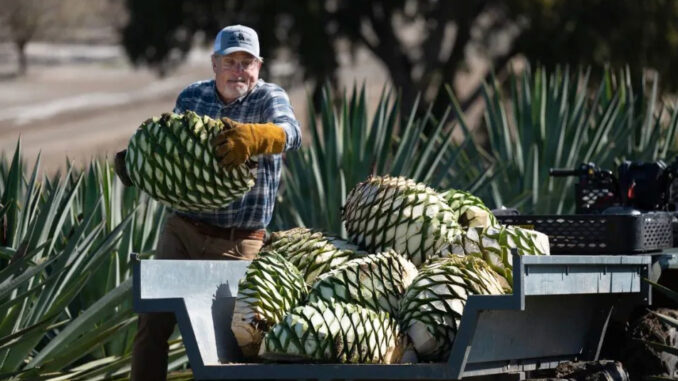
On recent a brisk March morning in Woodland’s rolling hills, Raul “Reppo” Chavez was already covered in sweat.
Chavez and his cousin Antonio had spent the last half-hour hacking away at their agave plants — monstrous pineapple-looking beasts whose spiky leaves are all that can be seen above the soil.
The jimadors, as the farmers of the unique succulent are called, were harvesting agave that they planted six to eight years ago. After a stormy weekend, they will roast the 100-pound agave hearts (known as piñas) for five to seven days in an 8-feet-deep pit covered with pumice and volcanic rocks from around Mount Lassen.
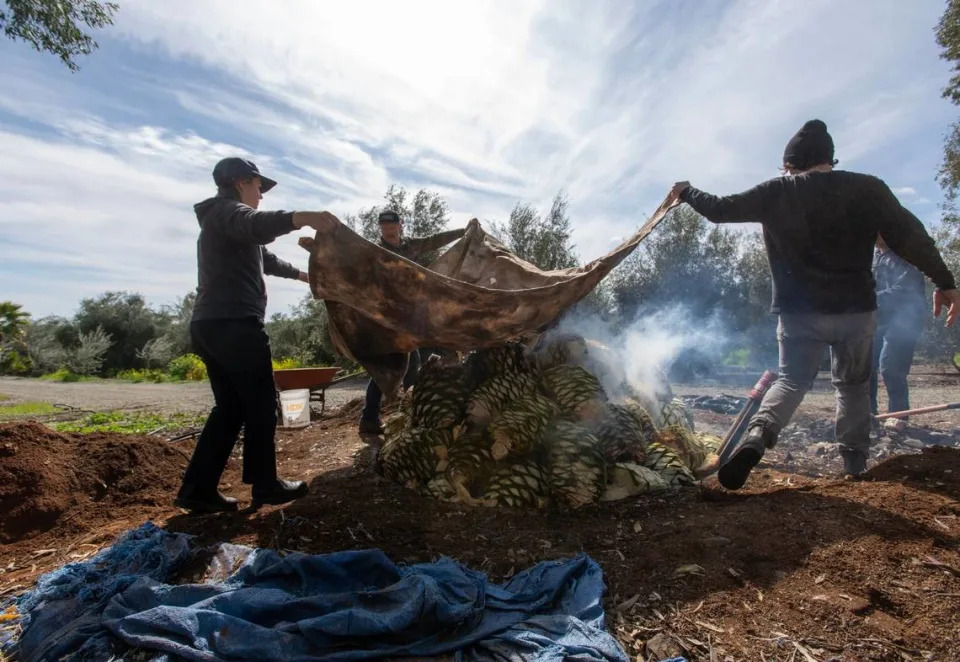
This is where the burgeoning “Mezcalifornia” movement begins. It ends up in small-batch agave spirits produced by craft distilleries throughout the state.
But don’t call it call it tequila or mezcal. That distinction is specific only to agave spirits produced in certain parts of Mexico.
Regardless of the name, it’s still a very niche, craft drink. Agave grows slowly and doesn’t yet have streamlined production in the United States. The resulting liquors are scarce and expensive.
Yet more growers are planting agave — and tequila and mezcal are among the United States’ most popular drinks. When asked about the demand for California-grown agave, farmer and agave advocate Craig Reynolds replied, “I think it’s endless.”
“The craft distillers in California would buy up every mature agave 10 times what I’m producing, 100 times. They’re able to sell their agave spirits at a premium,” Reynolds said. “And it’s just a matter of it scaling up. We have a long way to go to ever come close to saturating the market for agave spirits, in my opinion.”
How agave movement got started
Agave plants grow all over California, from midtown Sacramento sidewalk plots to dirt patches bordering freeways. But most aren’t Blue Weber agave (agave tequilana), the kind most commonly used for distilling tequila and mezcal.
That’s what Reynolds and Chavez grow on neighboring hillsides owned by brothers Joe and Tom Muller in Woodland. The Chavez cousins became acquainted with the industry while growing up in the Mexican state of Jalisco where tequila is made, in a 6,000-person town called Tonaya.
“Tonaya is a little town, but it’s got a lot, a lot of acres of agave. So we started to work a little bit over there. Not too much — more over here, when (Reynolds) came and started to plant that (plot),” Reppo Chavez said.
Reynolds began growing agave in Colima, Mexico in 2006 that would later be used to make Dos Volcanes tequila, which was sold to raise money for a nonprofit called Project Amigo.
Reynolds used his vacation days to check up on the agave and moonlighted as a Dos Volcanes importer to the U.S. while he was working full time as then-state Sen. Lois Wolk’s chief of staff. After retiring, he planted his first stateside agave in 2014.

He started with 500 plants and ended up with a movement. St. George Spirits master distiller Lance Winters, who is based in Alameda, made the first batch of spirits in 2019. Others came calling, both for processed agave and seedlings to start their own plots.
Reynolds founded the California Agave Council in April 2020 to unite growers and set standards across the board. One such principle, signed into state law in September: any bottle marketed as California agave spirits must be 100% made from agave. Traditional tequila requires only 51% agave juice, with the rest coming from corn or cane sugar and coloring agents.
Though Reynolds pioneered commercial agave production in California, he’s quick to differentiate between himself and “real farmers” such as the Chavez cousins, who harvest his plants as well as their own.
That harvesting is hard work. Once the Chavez cousins cut the agaves’ quiotes (flowering stalks that shoot from the center and indicate the plant has fully matured) they have about eight months to extract the piñas.
The jimadors use two types of coas (poles with sharp, round heads) to hack off the spiky leaves and root out the piñas, which they then pull out of the dirt by hand. All that time spent growing, and that’s it for the agave, which can be harvested precisely once.
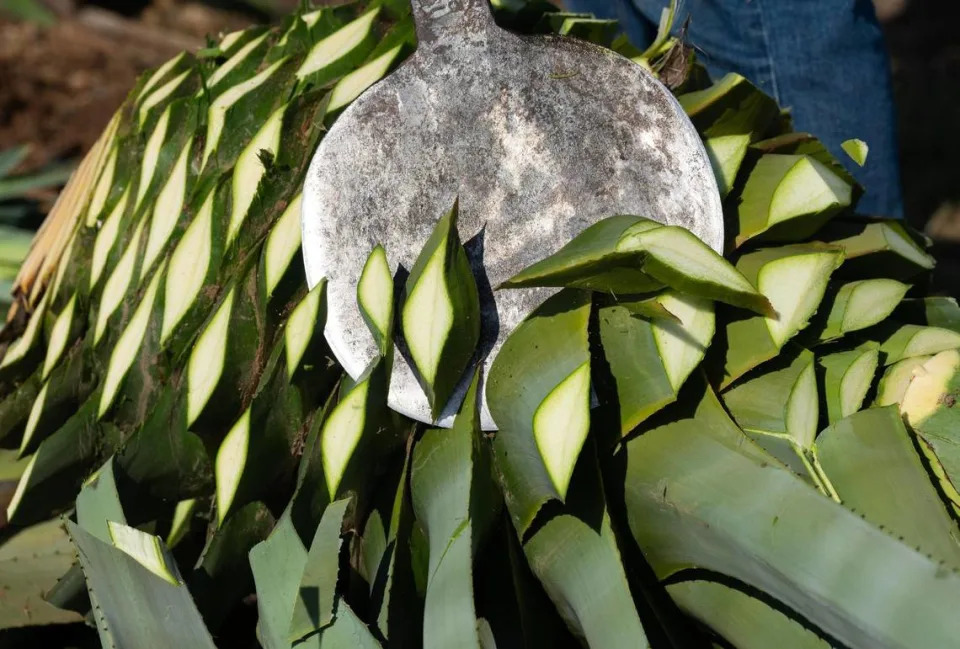
They then load the piñas into a truck for roasting, which can take another week once the subterranean oven is constructed. The agave leaves are then tilled back into the soil where beans, clover and mustard grow as cover crops.
Once roasted, the piñas are shredded and pressed to extract their sugary juices. Liquor makers then ferment and distill that liquid, proof it down to something around 40-45% ABV and bottle it for sale. Each 750-milliliter bottle requires about 11 pounds of agave.
When Venus Spirits began importing Mexican agave juice to make spirits in 2014, the Santa Cruz distillery was one of three in the U.S. to do so, founder and distiller Sean Venus said.
A couple hundred distillers do the same now, Venus said, but not many get their agave from California. Venus Spirits is one of the fortunate few. It released 450 bottles of El Ladrón Yolo, its first California-grown take on tequila, in 2021, using Reynolds’ agave.
The first El Ladrón Yolo bottles were sold only in the distillery’s tasting room, though the next batch will be slightly larger and distributed through other retailers. Venus Spirits still makes Mexican agave spirits, but they’re not the same.
“It’s quite a bit different. We get more of the vegetal notes from California agave. It’s less sweet, but more minerally, so it’s got more of a true character and flavor than Mexican agave spirits,” Venus said. “It’s a really interesting thing. We’re roasting over almond wood, and a little bit of that smoke character gets into the agave and comes through in the spirits.”
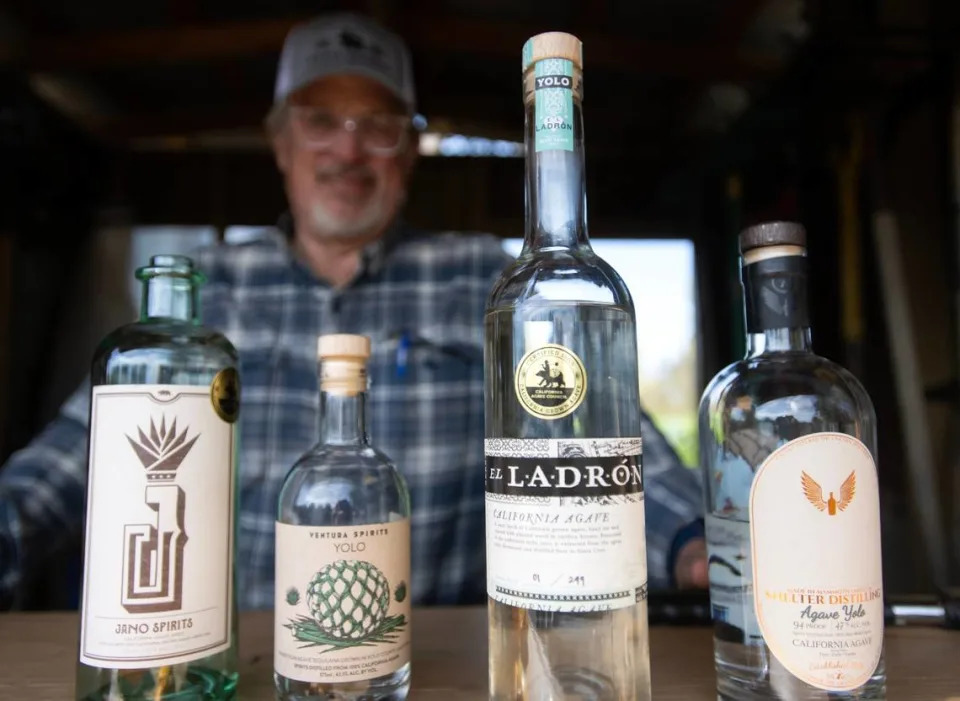
California dirt costs more than Jalisco land, and the traditional cooking method Reynolds uses is time-intensive.
Those factors drive the price of the resulting beverage up: a bottle of El Ladrón Yolo sells for $90, while Venus Spirits’ liquors made from Mexican agave go for $42-$68.
Yet demand is high. Americans are expected to spend more than $13.3 billion on agave spirits tequila and mezcal this year, overtaking vodka and whiskey as the nation’s most-bought spirit, according to beverage research firm IWSR.
Venus and Reynolds expect prices to fall as California’s agave industry grows and becomes more efficient. If more California farmers grow agave, Venus Spirits will buy it.
In the meantime, Venus has planted a few seedlings around the distillery and is exploring larger plots outside of Santa Cruz. “The whole kind of farm-to-bottle thing is a process that is really interesting and unseen by (many) other distillers,” Venus said. “I think it’s something really unique that is happening right now, and we’re just excited to be part of it.”
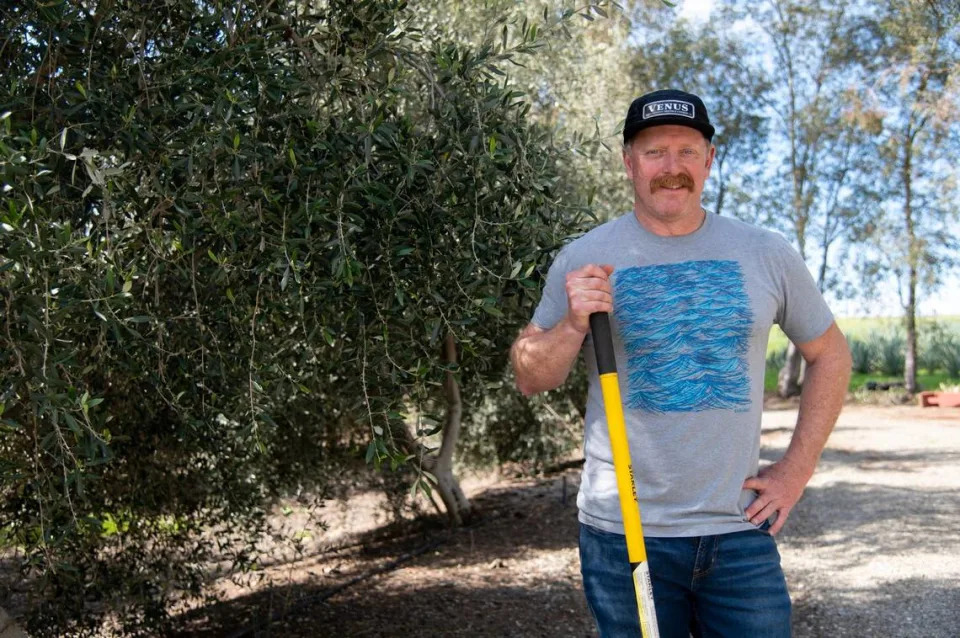
Right crop, right place?
California’s natural growing conditions — high heat, fertile soil and a Mediterranean climate — make the state suitable for agave as well as many other crops. The California Agave Council now includes farmers from counties as disparate as Lake, San Luis Obispo and Imperial.
But the Central Valley is the area to watch, because this crop takes little precious water. That has farmers like Stuart Woolf ripping out their almond trees in favor of agave plants.
Woolf’s family has farmed in the Westlands Water District since the late 1940s. The family today grows nuts, cotton, alliums, winegrapes, grains and more on 20,000 acres around Huron in Fresno County. Yet with new state laws such as the Sustainable Groundwater Management Act (SGMA) restricting the amount of water farmers can pump, Woolf estimates he’ll eventually fallow 40% of his land.
Woolf plans to lease some of the space to industrial solar companies, but wants to keep farming the crops he can. He began growing 4,000 agave plants in a test plot in 2019. While none is mature yet, they’re thriving so far, he said.
“Is this something akin to when California first started getting into the winegrape business, and we’d have naysayers all over the world saying ‘good luck with that?’” Woolf wondered. “When I drive around my neighborhood, there are agaves everywhere, just in gardens or off the road. We have plants out there in farm country where nobody is irrigating them and they seem to be thriving.”
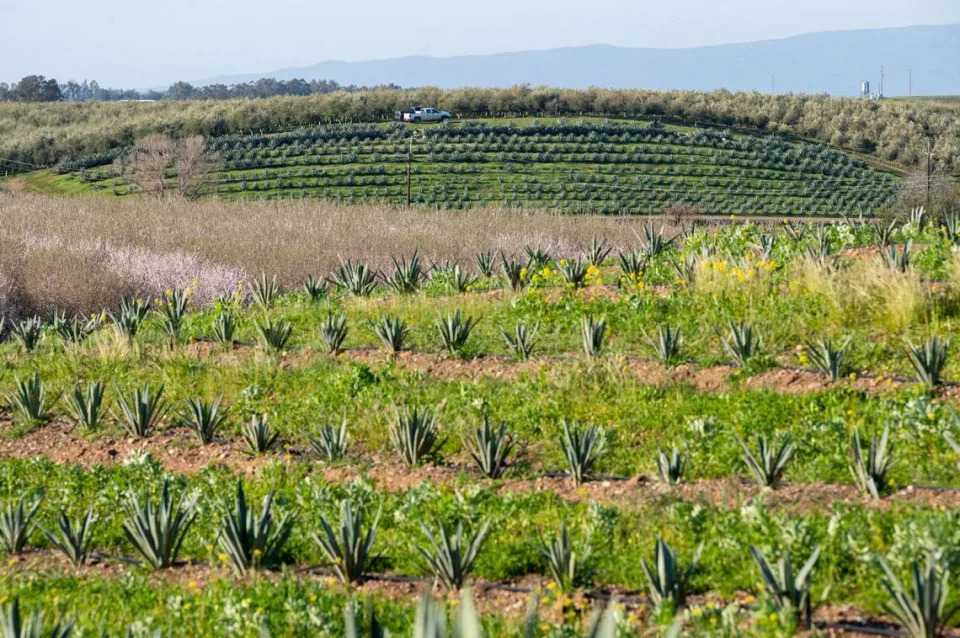
They’re doing so well, in fact, that Woolf will plant 160 acres of agave this year and he plans to do the same in subsequent years — roughly 200,000 plants per year. His five children had little interest in carrying on the family’s farming legacy, yet when he told them about his agave plans over dinner, they all wanted in.
Woolf is doing all this planting with hopes that someone else will build a commercial plant to cut, heat and extract juice from that many piñas, because none currently exists in California. If no one does by the time they’re ready to be harvested, he still has a plan.
“I’m going to plant all these things and if I can’t get somebody to take them off my hands, I’m going to process them myself,” Woolf said. “It really is a chicken-and-the-egg kind of thing, and I would be getting in a lot deeper if I were to do that. But I don’t know, I’m kind of intrigued by the whole idea.”
Other people are getting involved on the research front, thanks to Woolf’s funding. He and his wife Lisa donated $100,000 last year for UC Davis researchers to investigate agave’s viability in California, with a focus on identifying growing locations, plant attributes and future funding sources.
Agave can survive with little to no water during dry years, but frost can be killer and is more likely in California than Mexico. If water is available, Woolf is looking at using drip irrigation for faster-growing, sugarier plants rather than the dry farming typically done in Mexico.
Agave spirits are rooted in Mexico, and mezcal in particular carries no small amount of mysticism and cultural lore. But California can’t and isn’t making tequila or mezcal. It’s making its own spirit.
“We’re just another part of the family,” Reynolds said. “We’re not trying to take Mexican traditions. We’re California distillers doing their own thing, learning along the way.”




Be the first to comment